Marketing Essentials: A Comparison of Sainsbury’s and Morrisons
VerifiedAdded on 2023/01/06
|11
|2892
|64
AI Summary
This report discusses the marketing mix of Sainsbury’s and Morrisons, comparing their product, price, place, and promotion strategies. It also includes a marketing plan for Sainsbury’s.
Contribute Materials
Your contribution can guide someone’s learning journey. Share your
documents today.
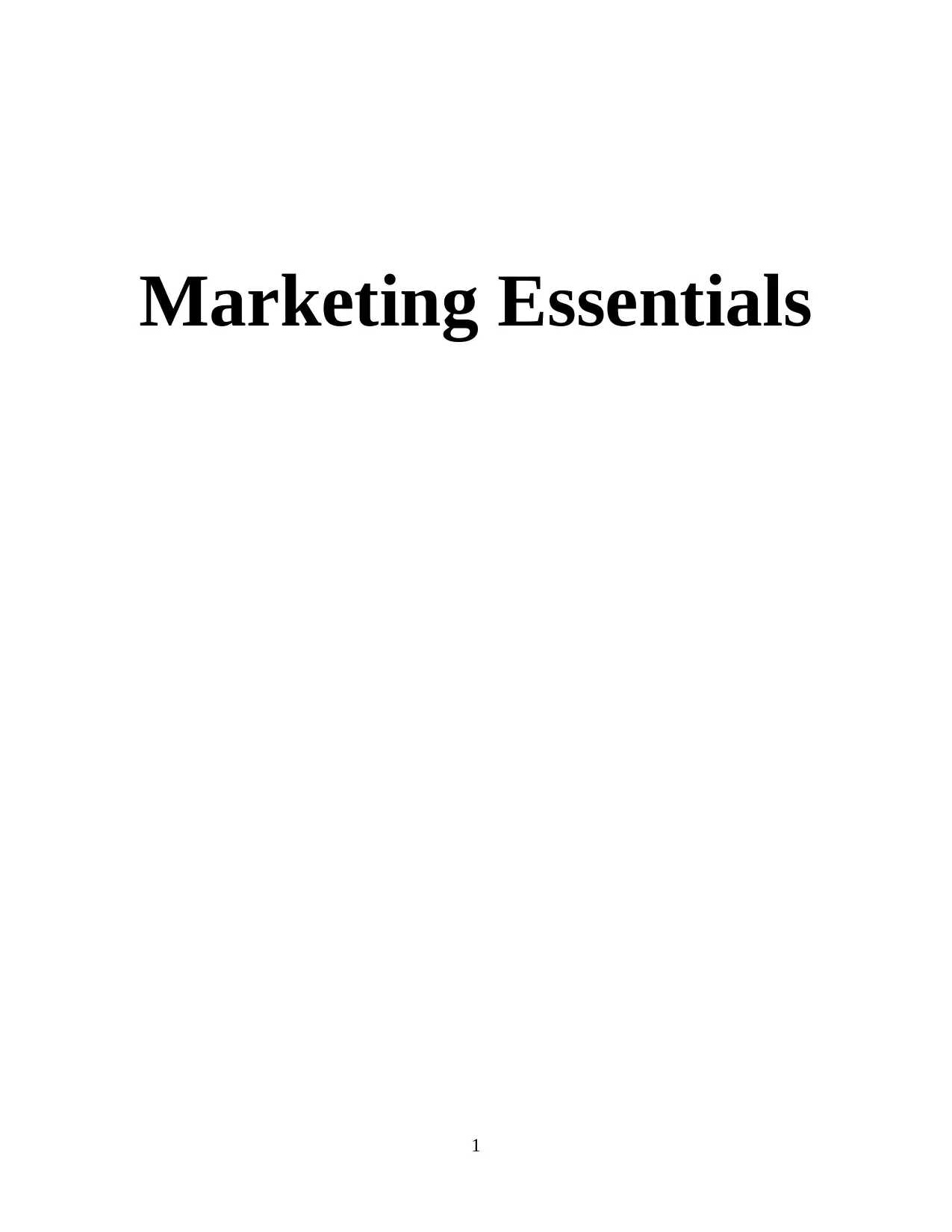
Marketing Essentials
1
1
Secure Best Marks with AI Grader
Need help grading? Try our AI Grader for instant feedback on your assignments.

Table of Contents
INTRODUCTION...........................................................................................................................3
Comparison in Marketing Mix of Sainsbury’s and Morrisons....................................................3
Marketing Plan for Sainsbury’s...................................................................................................6
CONCLUSION..............................................................................................................................10
REFERENCES..............................................................................................................................11
2
INTRODUCTION...........................................................................................................................3
Comparison in Marketing Mix of Sainsbury’s and Morrisons....................................................3
Marketing Plan for Sainsbury’s...................................................................................................6
CONCLUSION..............................................................................................................................10
REFERENCES..............................................................................................................................11
2
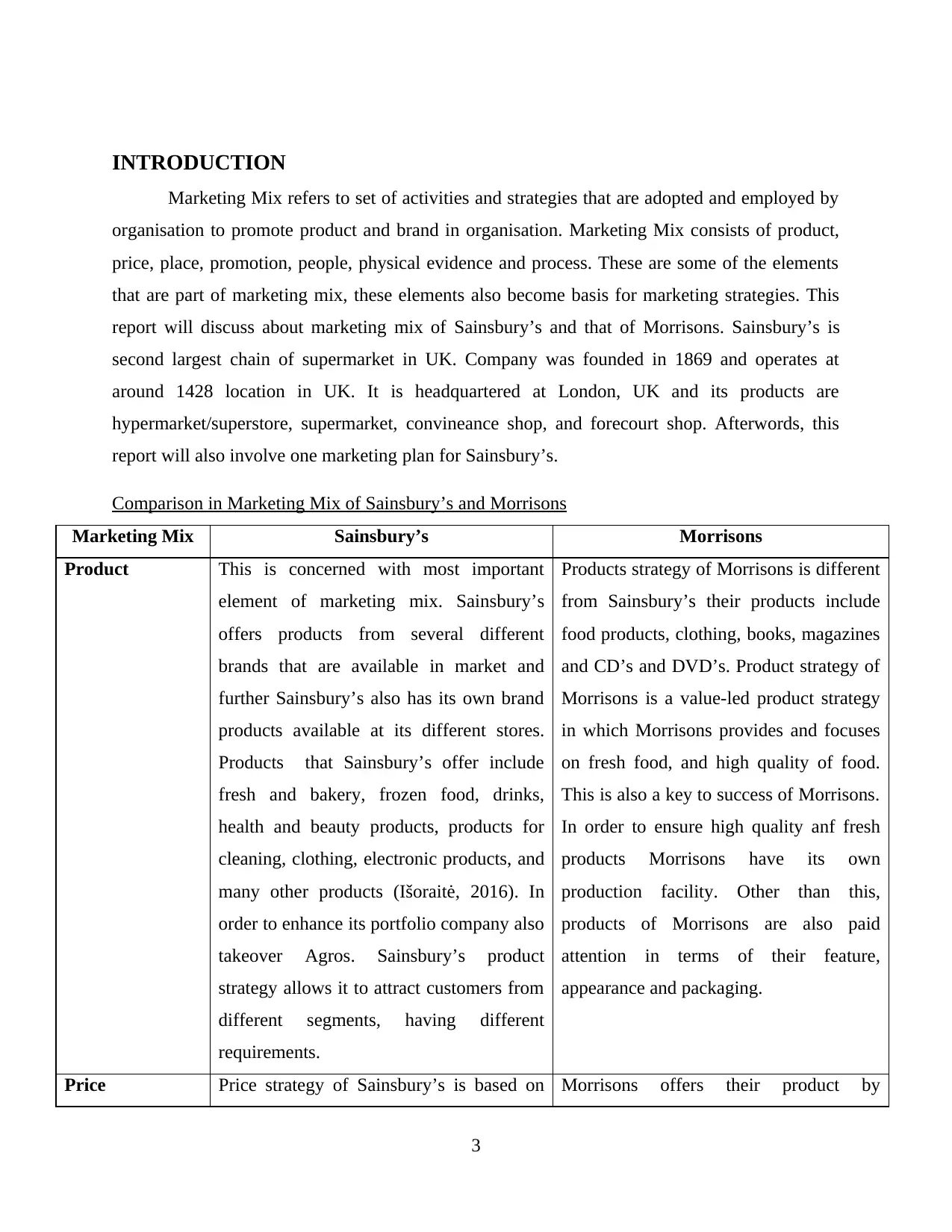
INTRODUCTION
Marketing Mix refers to set of activities and strategies that are adopted and employed by
organisation to promote product and brand in organisation. Marketing Mix consists of product,
price, place, promotion, people, physical evidence and process. These are some of the elements
that are part of marketing mix, these elements also become basis for marketing strategies. This
report will discuss about marketing mix of Sainsbury’s and that of Morrisons. Sainsbury’s is
second largest chain of supermarket in UK. Company was founded in 1869 and operates at
around 1428 location in UK. It is headquartered at London, UK and its products are
hypermarket/superstore, supermarket, convineance shop, and forecourt shop. Afterwords, this
report will also involve one marketing plan for Sainsbury’s.
Comparison in Marketing Mix of Sainsbury’s and Morrisons
Marketing Mix Sainsbury’s Morrisons
Product This is concerned with most important
element of marketing mix. Sainsbury’s
offers products from several different
brands that are available in market and
further Sainsbury’s also has its own brand
products available at its different stores.
Products that Sainsbury’s offer include
fresh and bakery, frozen food, drinks,
health and beauty products, products for
cleaning, clothing, electronic products, and
many other products (Išoraitė, 2016). In
order to enhance its portfolio company also
takeover Agros. Sainsbury’s product
strategy allows it to attract customers from
different segments, having different
requirements.
Products strategy of Morrisons is different
from Sainsbury’s their products include
food products, clothing, books, magazines
and CD’s and DVD’s. Product strategy of
Morrisons is a value-led product strategy
in which Morrisons provides and focuses
on fresh food, and high quality of food.
This is also a key to success of Morrisons.
In order to ensure high quality anf fresh
products Morrisons have its own
production facility. Other than this,
products of Morrisons are also paid
attention in terms of their feature,
appearance and packaging.
Price Price strategy of Sainsbury’s is based on Morrisons offers their product by
3
Marketing Mix refers to set of activities and strategies that are adopted and employed by
organisation to promote product and brand in organisation. Marketing Mix consists of product,
price, place, promotion, people, physical evidence and process. These are some of the elements
that are part of marketing mix, these elements also become basis for marketing strategies. This
report will discuss about marketing mix of Sainsbury’s and that of Morrisons. Sainsbury’s is
second largest chain of supermarket in UK. Company was founded in 1869 and operates at
around 1428 location in UK. It is headquartered at London, UK and its products are
hypermarket/superstore, supermarket, convineance shop, and forecourt shop. Afterwords, this
report will also involve one marketing plan for Sainsbury’s.
Comparison in Marketing Mix of Sainsbury’s and Morrisons
Marketing Mix Sainsbury’s Morrisons
Product This is concerned with most important
element of marketing mix. Sainsbury’s
offers products from several different
brands that are available in market and
further Sainsbury’s also has its own brand
products available at its different stores.
Products that Sainsbury’s offer include
fresh and bakery, frozen food, drinks,
health and beauty products, products for
cleaning, clothing, electronic products, and
many other products (Išoraitė, 2016). In
order to enhance its portfolio company also
takeover Agros. Sainsbury’s product
strategy allows it to attract customers from
different segments, having different
requirements.
Products strategy of Morrisons is different
from Sainsbury’s their products include
food products, clothing, books, magazines
and CD’s and DVD’s. Product strategy of
Morrisons is a value-led product strategy
in which Morrisons provides and focuses
on fresh food, and high quality of food.
This is also a key to success of Morrisons.
In order to ensure high quality anf fresh
products Morrisons have its own
production facility. Other than this,
products of Morrisons are also paid
attention in terms of their feature,
appearance and packaging.
Price Price strategy of Sainsbury’s is based on Morrisons offers their product by
3
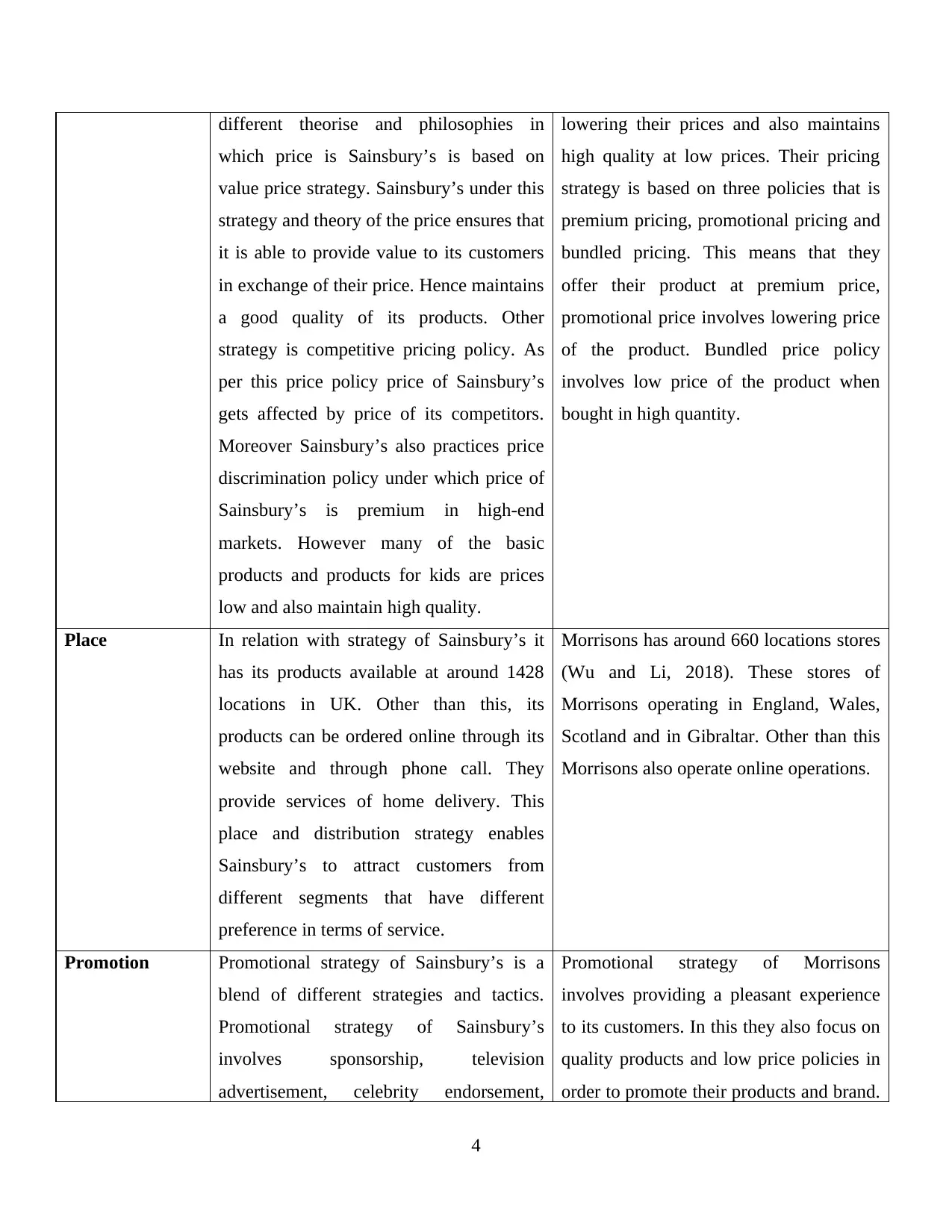
different theorise and philosophies in
which price is Sainsbury’s is based on
value price strategy. Sainsbury’s under this
strategy and theory of the price ensures that
it is able to provide value to its customers
in exchange of their price. Hence maintains
a good quality of its products. Other
strategy is competitive pricing policy. As
per this price policy price of Sainsbury’s
gets affected by price of its competitors.
Moreover Sainsbury’s also practices price
discrimination policy under which price of
Sainsbury’s is premium in high-end
markets. However many of the basic
products and products for kids are prices
low and also maintain high quality.
lowering their prices and also maintains
high quality at low prices. Their pricing
strategy is based on three policies that is
premium pricing, promotional pricing and
bundled pricing. This means that they
offer their product at premium price,
promotional price involves lowering price
of the product. Bundled price policy
involves low price of the product when
bought in high quantity.
Place In relation with strategy of Sainsbury’s it
has its products available at around 1428
locations in UK. Other than this, its
products can be ordered online through its
website and through phone call. They
provide services of home delivery. This
place and distribution strategy enables
Sainsbury’s to attract customers from
different segments that have different
preference in terms of service.
Morrisons has around 660 locations stores
(Wu and Li, 2018). These stores of
Morrisons operating in England, Wales,
Scotland and in Gibraltar. Other than this
Morrisons also operate online operations.
Promotion Promotional strategy of Sainsbury’s is a
blend of different strategies and tactics.
Promotional strategy of Sainsbury’s
involves sponsorship, television
advertisement, celebrity endorsement,
Promotional strategy of Morrisons
involves providing a pleasant experience
to its customers. In this they also focus on
quality products and low price policies in
order to promote their products and brand.
4
which price is Sainsbury’s is based on
value price strategy. Sainsbury’s under this
strategy and theory of the price ensures that
it is able to provide value to its customers
in exchange of their price. Hence maintains
a good quality of its products. Other
strategy is competitive pricing policy. As
per this price policy price of Sainsbury’s
gets affected by price of its competitors.
Moreover Sainsbury’s also practices price
discrimination policy under which price of
Sainsbury’s is premium in high-end
markets. However many of the basic
products and products for kids are prices
low and also maintain high quality.
lowering their prices and also maintains
high quality at low prices. Their pricing
strategy is based on three policies that is
premium pricing, promotional pricing and
bundled pricing. This means that they
offer their product at premium price,
promotional price involves lowering price
of the product. Bundled price policy
involves low price of the product when
bought in high quantity.
Place In relation with strategy of Sainsbury’s it
has its products available at around 1428
locations in UK. Other than this, its
products can be ordered online through its
website and through phone call. They
provide services of home delivery. This
place and distribution strategy enables
Sainsbury’s to attract customers from
different segments that have different
preference in terms of service.
Morrisons has around 660 locations stores
(Wu and Li, 2018). These stores of
Morrisons operating in England, Wales,
Scotland and in Gibraltar. Other than this
Morrisons also operate online operations.
Promotion Promotional strategy of Sainsbury’s is a
blend of different strategies and tactics.
Promotional strategy of Sainsbury’s
involves sponsorship, television
advertisement, celebrity endorsement,
Promotional strategy of Morrisons
involves providing a pleasant experience
to its customers. In this they also focus on
quality products and low price policies in
order to promote their products and brand.
4
Secure Best Marks with AI Grader
Need help grading? Try our AI Grader for instant feedback on your assignments.
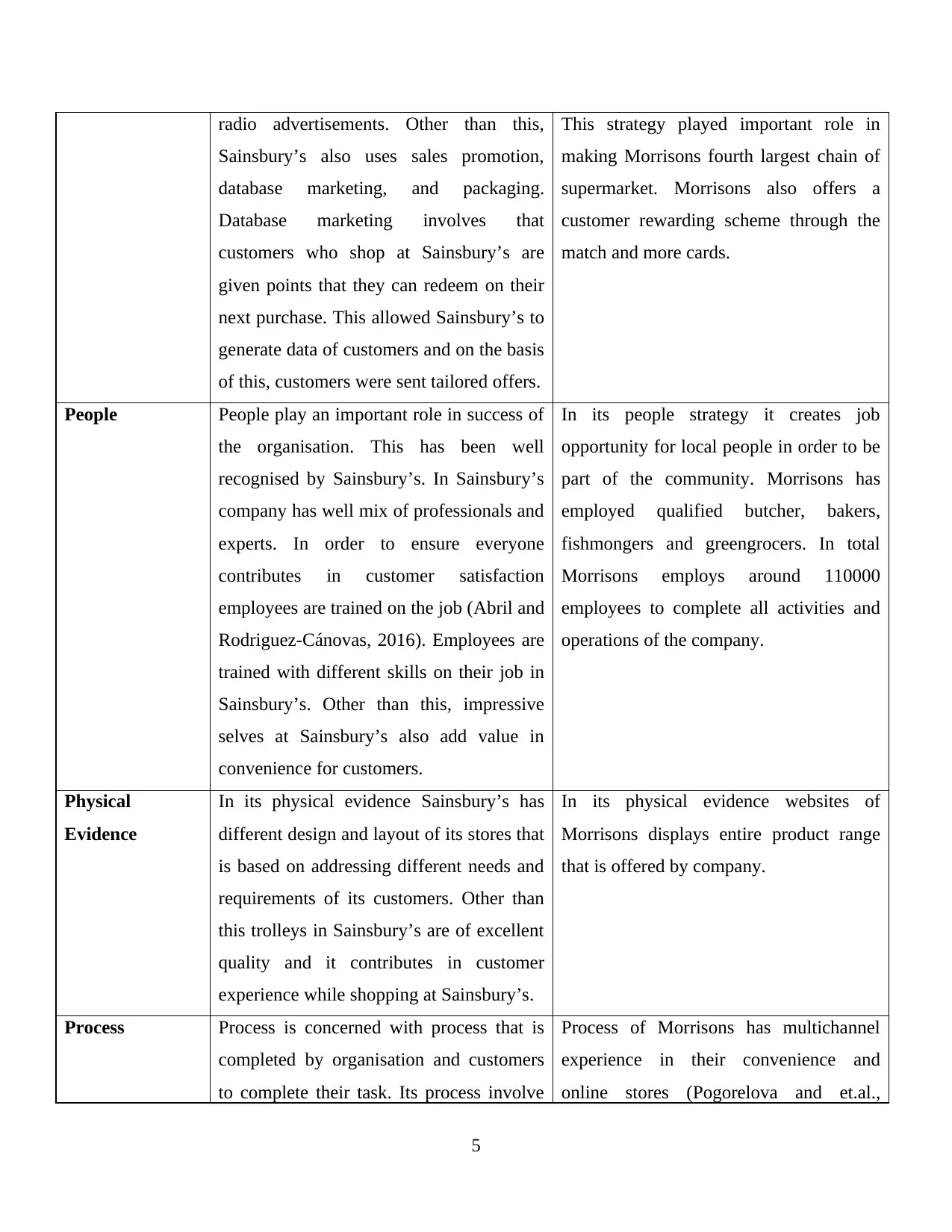
radio advertisements. Other than this,
Sainsbury’s also uses sales promotion,
database marketing, and packaging.
Database marketing involves that
customers who shop at Sainsbury’s are
given points that they can redeem on their
next purchase. This allowed Sainsbury’s to
generate data of customers and on the basis
of this, customers were sent tailored offers.
This strategy played important role in
making Morrisons fourth largest chain of
supermarket. Morrisons also offers a
customer rewarding scheme through the
match and more cards.
People People play an important role in success of
the organisation. This has been well
recognised by Sainsbury’s. In Sainsbury’s
company has well mix of professionals and
experts. In order to ensure everyone
contributes in customer satisfaction
employees are trained on the job (Abril and
Rodriguez-Cánovas, 2016). Employees are
trained with different skills on their job in
Sainsbury’s. Other than this, impressive
selves at Sainsbury’s also add value in
convenience for customers.
In its people strategy it creates job
opportunity for local people in order to be
part of the community. Morrisons has
employed qualified butcher, bakers,
fishmongers and greengrocers. In total
Morrisons employs around 110000
employees to complete all activities and
operations of the company.
Physical
Evidence
In its physical evidence Sainsbury’s has
different design and layout of its stores that
is based on addressing different needs and
requirements of its customers. Other than
this trolleys in Sainsbury’s are of excellent
quality and it contributes in customer
experience while shopping at Sainsbury’s.
In its physical evidence websites of
Morrisons displays entire product range
that is offered by company.
Process Process is concerned with process that is
completed by organisation and customers
to complete their task. Its process involve
Process of Morrisons has multichannel
experience in their convenience and
online stores (Pogorelova and et.al.,
5
Sainsbury’s also uses sales promotion,
database marketing, and packaging.
Database marketing involves that
customers who shop at Sainsbury’s are
given points that they can redeem on their
next purchase. This allowed Sainsbury’s to
generate data of customers and on the basis
of this, customers were sent tailored offers.
This strategy played important role in
making Morrisons fourth largest chain of
supermarket. Morrisons also offers a
customer rewarding scheme through the
match and more cards.
People People play an important role in success of
the organisation. This has been well
recognised by Sainsbury’s. In Sainsbury’s
company has well mix of professionals and
experts. In order to ensure everyone
contributes in customer satisfaction
employees are trained on the job (Abril and
Rodriguez-Cánovas, 2016). Employees are
trained with different skills on their job in
Sainsbury’s. Other than this, impressive
selves at Sainsbury’s also add value in
convenience for customers.
In its people strategy it creates job
opportunity for local people in order to be
part of the community. Morrisons has
employed qualified butcher, bakers,
fishmongers and greengrocers. In total
Morrisons employs around 110000
employees to complete all activities and
operations of the company.
Physical
Evidence
In its physical evidence Sainsbury’s has
different design and layout of its stores that
is based on addressing different needs and
requirements of its customers. Other than
this trolleys in Sainsbury’s are of excellent
quality and it contributes in customer
experience while shopping at Sainsbury’s.
In its physical evidence websites of
Morrisons displays entire product range
that is offered by company.
Process Process is concerned with process that is
completed by organisation and customers
to complete their task. Its process involve
Process of Morrisons has multichannel
experience in their convenience and
online stores (Pogorelova and et.al.,
5
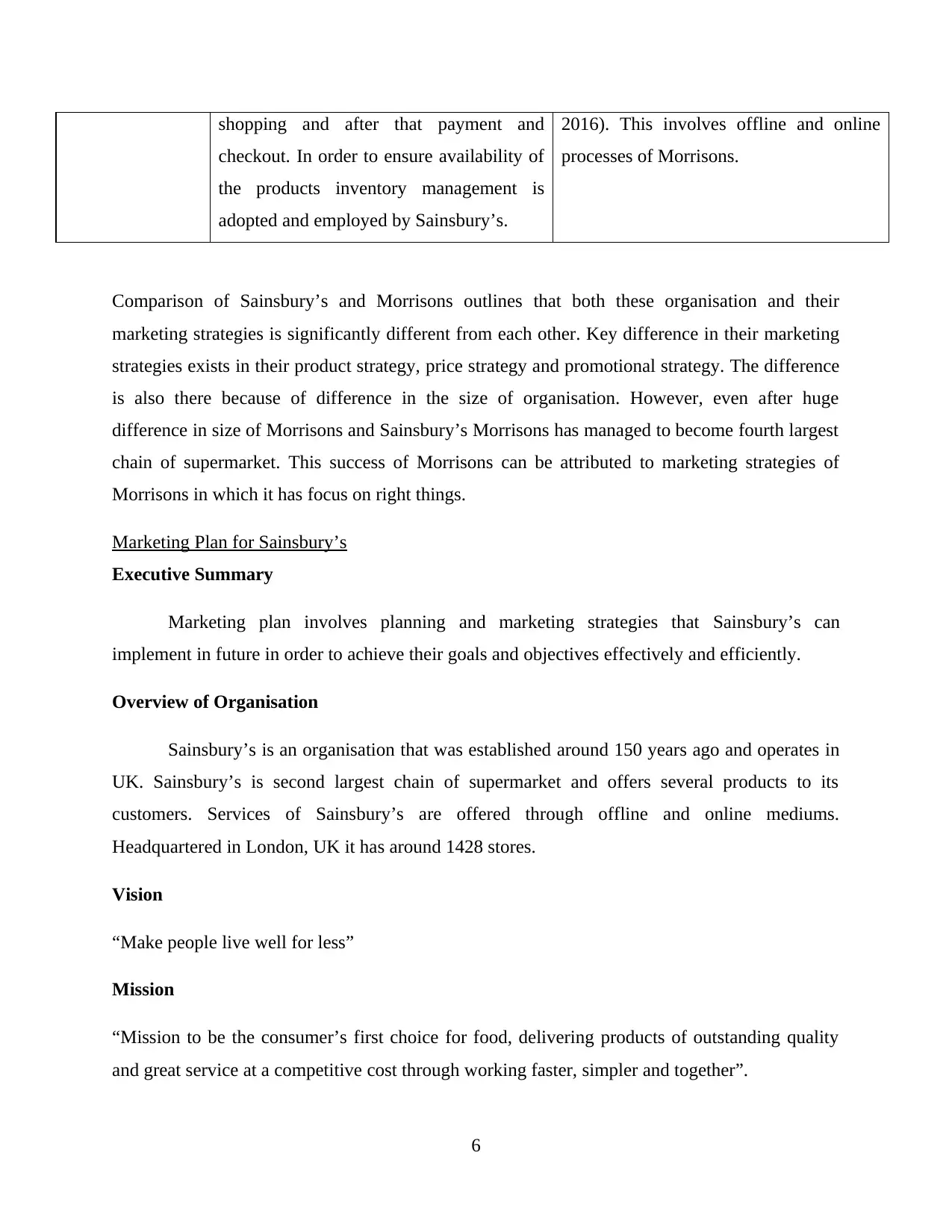
shopping and after that payment and
checkout. In order to ensure availability of
the products inventory management is
adopted and employed by Sainsbury’s.
2016). This involves offline and online
processes of Morrisons.
Comparison of Sainsbury’s and Morrisons outlines that both these organisation and their
marketing strategies is significantly different from each other. Key difference in their marketing
strategies exists in their product strategy, price strategy and promotional strategy. The difference
is also there because of difference in the size of organisation. However, even after huge
difference in size of Morrisons and Sainsbury’s Morrisons has managed to become fourth largest
chain of supermarket. This success of Morrisons can be attributed to marketing strategies of
Morrisons in which it has focus on right things.
Marketing Plan for Sainsbury’s
Executive Summary
Marketing plan involves planning and marketing strategies that Sainsbury’s can
implement in future in order to achieve their goals and objectives effectively and efficiently.
Overview of Organisation
Sainsbury’s is an organisation that was established around 150 years ago and operates in
UK. Sainsbury’s is second largest chain of supermarket and offers several products to its
customers. Services of Sainsbury’s are offered through offline and online mediums.
Headquartered in London, UK it has around 1428 stores.
Vision
“Make people live well for less”
Mission
“Mission to be the consumer’s first choice for food, delivering products of outstanding quality
and great service at a competitive cost through working faster, simpler and together”.
6
checkout. In order to ensure availability of
the products inventory management is
adopted and employed by Sainsbury’s.
2016). This involves offline and online
processes of Morrisons.
Comparison of Sainsbury’s and Morrisons outlines that both these organisation and their
marketing strategies is significantly different from each other. Key difference in their marketing
strategies exists in their product strategy, price strategy and promotional strategy. The difference
is also there because of difference in the size of organisation. However, even after huge
difference in size of Morrisons and Sainsbury’s Morrisons has managed to become fourth largest
chain of supermarket. This success of Morrisons can be attributed to marketing strategies of
Morrisons in which it has focus on right things.
Marketing Plan for Sainsbury’s
Executive Summary
Marketing plan involves planning and marketing strategies that Sainsbury’s can
implement in future in order to achieve their goals and objectives effectively and efficiently.
Overview of Organisation
Sainsbury’s is an organisation that was established around 150 years ago and operates in
UK. Sainsbury’s is second largest chain of supermarket and offers several products to its
customers. Services of Sainsbury’s are offered through offline and online mediums.
Headquartered in London, UK it has around 1428 stores.
Vision
“Make people live well for less”
Mission
“Mission to be the consumer’s first choice for food, delivering products of outstanding quality
and great service at a competitive cost through working faster, simpler and together”.
6
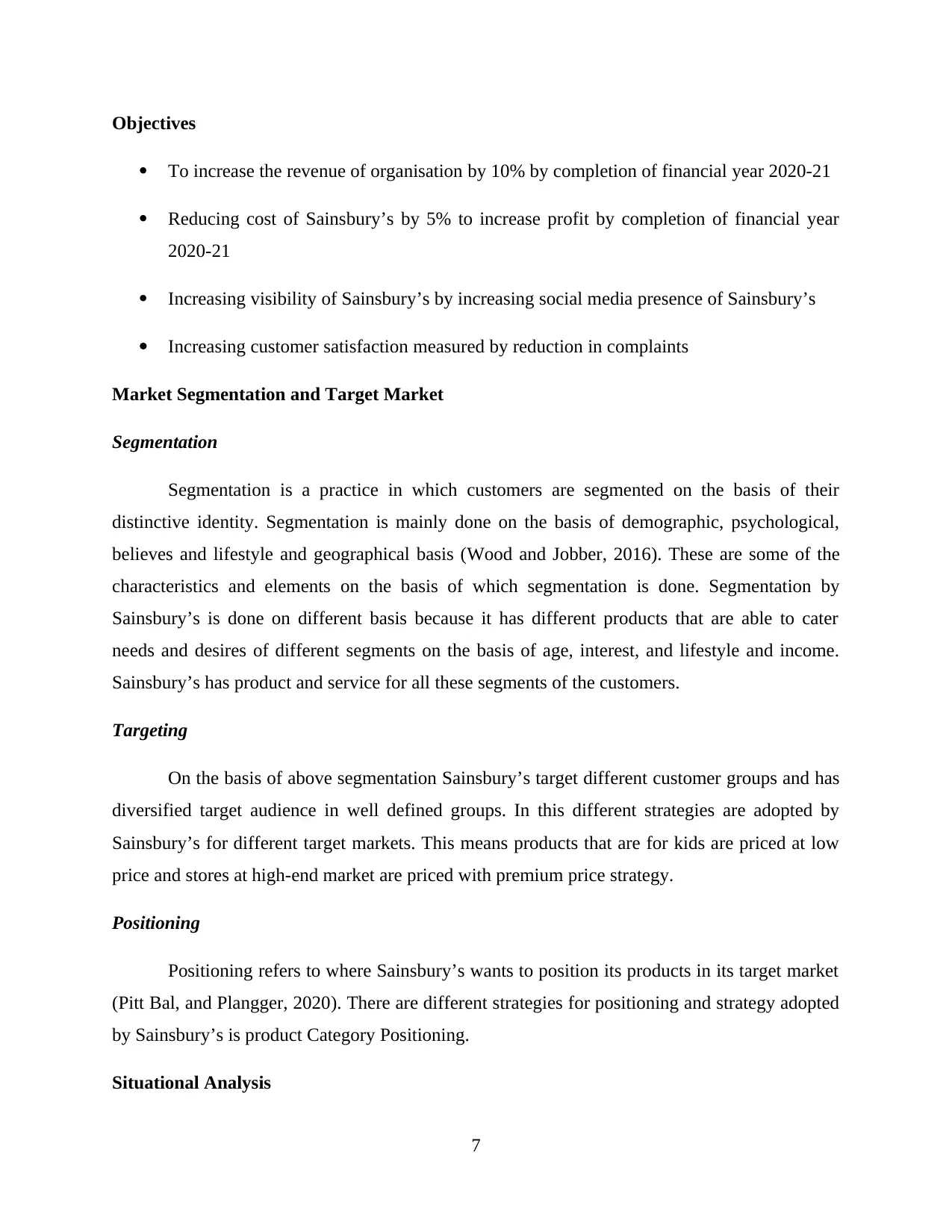
Objectives
To increase the revenue of organisation by 10% by completion of financial year 2020-21
Reducing cost of Sainsbury’s by 5% to increase profit by completion of financial year
2020-21
Increasing visibility of Sainsbury’s by increasing social media presence of Sainsbury’s
Increasing customer satisfaction measured by reduction in complaints
Market Segmentation and Target Market
Segmentation
Segmentation is a practice in which customers are segmented on the basis of their
distinctive identity. Segmentation is mainly done on the basis of demographic, psychological,
believes and lifestyle and geographical basis (Wood and Jobber, 2016). These are some of the
characteristics and elements on the basis of which segmentation is done. Segmentation by
Sainsbury’s is done on different basis because it has different products that are able to cater
needs and desires of different segments on the basis of age, interest, and lifestyle and income.
Sainsbury’s has product and service for all these segments of the customers.
Targeting
On the basis of above segmentation Sainsbury’s target different customer groups and has
diversified target audience in well defined groups. In this different strategies are adopted by
Sainsbury’s for different target markets. This means products that are for kids are priced at low
price and stores at high-end market are priced with premium price strategy.
Positioning
Positioning refers to where Sainsbury’s wants to position its products in its target market
(Pitt Bal, and Plangger, 2020). There are different strategies for positioning and strategy adopted
by Sainsbury’s is product Category Positioning.
Situational Analysis
7
To increase the revenue of organisation by 10% by completion of financial year 2020-21
Reducing cost of Sainsbury’s by 5% to increase profit by completion of financial year
2020-21
Increasing visibility of Sainsbury’s by increasing social media presence of Sainsbury’s
Increasing customer satisfaction measured by reduction in complaints
Market Segmentation and Target Market
Segmentation
Segmentation is a practice in which customers are segmented on the basis of their
distinctive identity. Segmentation is mainly done on the basis of demographic, psychological,
believes and lifestyle and geographical basis (Wood and Jobber, 2016). These are some of the
characteristics and elements on the basis of which segmentation is done. Segmentation by
Sainsbury’s is done on different basis because it has different products that are able to cater
needs and desires of different segments on the basis of age, interest, and lifestyle and income.
Sainsbury’s has product and service for all these segments of the customers.
Targeting
On the basis of above segmentation Sainsbury’s target different customer groups and has
diversified target audience in well defined groups. In this different strategies are adopted by
Sainsbury’s for different target markets. This means products that are for kids are priced at low
price and stores at high-end market are priced with premium price strategy.
Positioning
Positioning refers to where Sainsbury’s wants to position its products in its target market
(Pitt Bal, and Plangger, 2020). There are different strategies for positioning and strategy adopted
by Sainsbury’s is product Category Positioning.
Situational Analysis
7
Paraphrase This Document
Need a fresh take? Get an instant paraphrase of this document with our AI Paraphraser
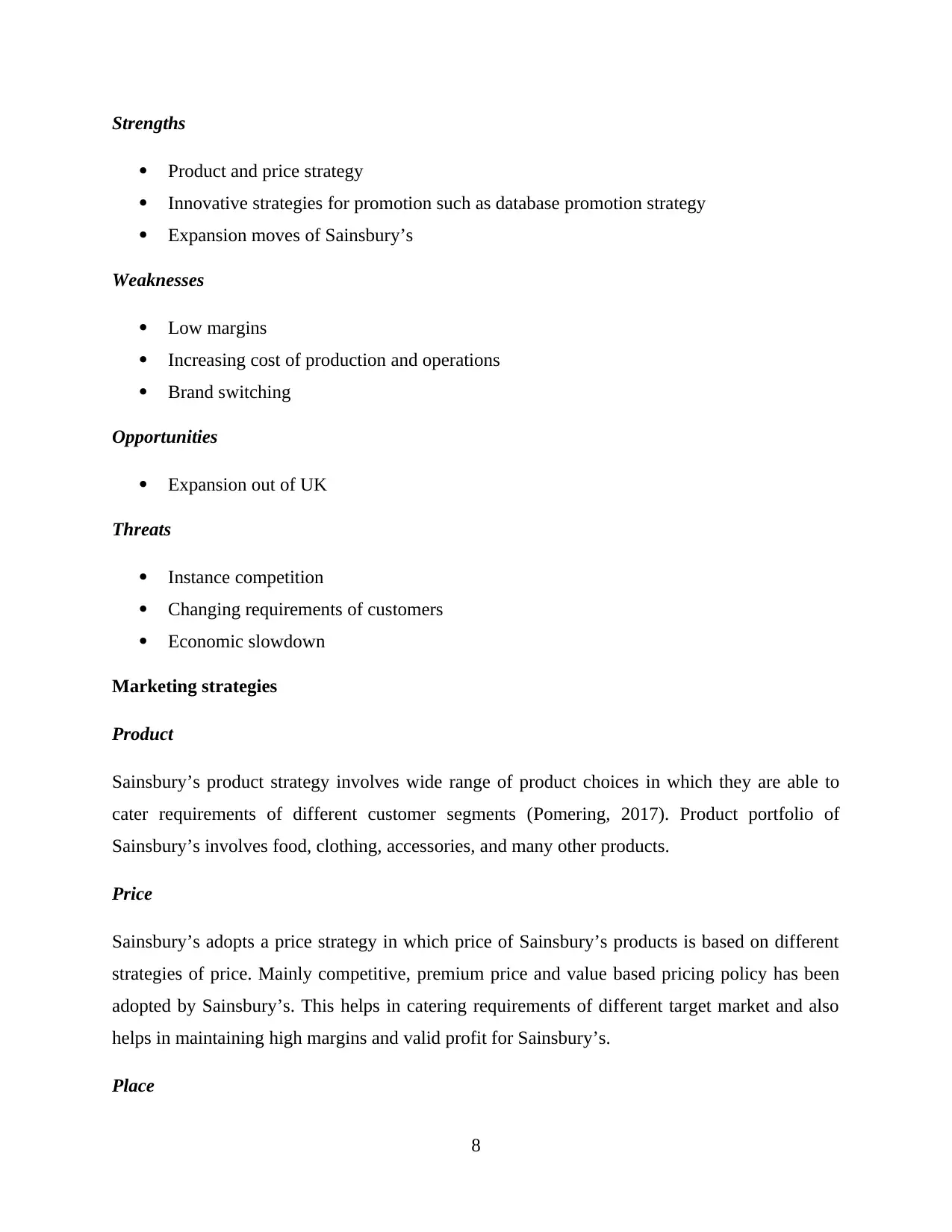
Strengths
Product and price strategy
Innovative strategies for promotion such as database promotion strategy
Expansion moves of Sainsbury’s
Weaknesses
Low margins
Increasing cost of production and operations
Brand switching
Opportunities
Expansion out of UK
Threats
Instance competition
Changing requirements of customers
Economic slowdown
Marketing strategies
Product
Sainsbury’s product strategy involves wide range of product choices in which they are able to
cater requirements of different customer segments (Pomering, 2017). Product portfolio of
Sainsbury’s involves food, clothing, accessories, and many other products.
Price
Sainsbury’s adopts a price strategy in which price of Sainsbury’s products is based on different
strategies of price. Mainly competitive, premium price and value based pricing policy has been
adopted by Sainsbury’s. This helps in catering requirements of different target market and also
helps in maintaining high margins and valid profit for Sainsbury’s.
Place
8
Product and price strategy
Innovative strategies for promotion such as database promotion strategy
Expansion moves of Sainsbury’s
Weaknesses
Low margins
Increasing cost of production and operations
Brand switching
Opportunities
Expansion out of UK
Threats
Instance competition
Changing requirements of customers
Economic slowdown
Marketing strategies
Product
Sainsbury’s product strategy involves wide range of product choices in which they are able to
cater requirements of different customer segments (Pomering, 2017). Product portfolio of
Sainsbury’s involves food, clothing, accessories, and many other products.
Price
Sainsbury’s adopts a price strategy in which price of Sainsbury’s products is based on different
strategies of price. Mainly competitive, premium price and value based pricing policy has been
adopted by Sainsbury’s. This helps in catering requirements of different target market and also
helps in maintaining high margins and valid profit for Sainsbury’s.
Place
8
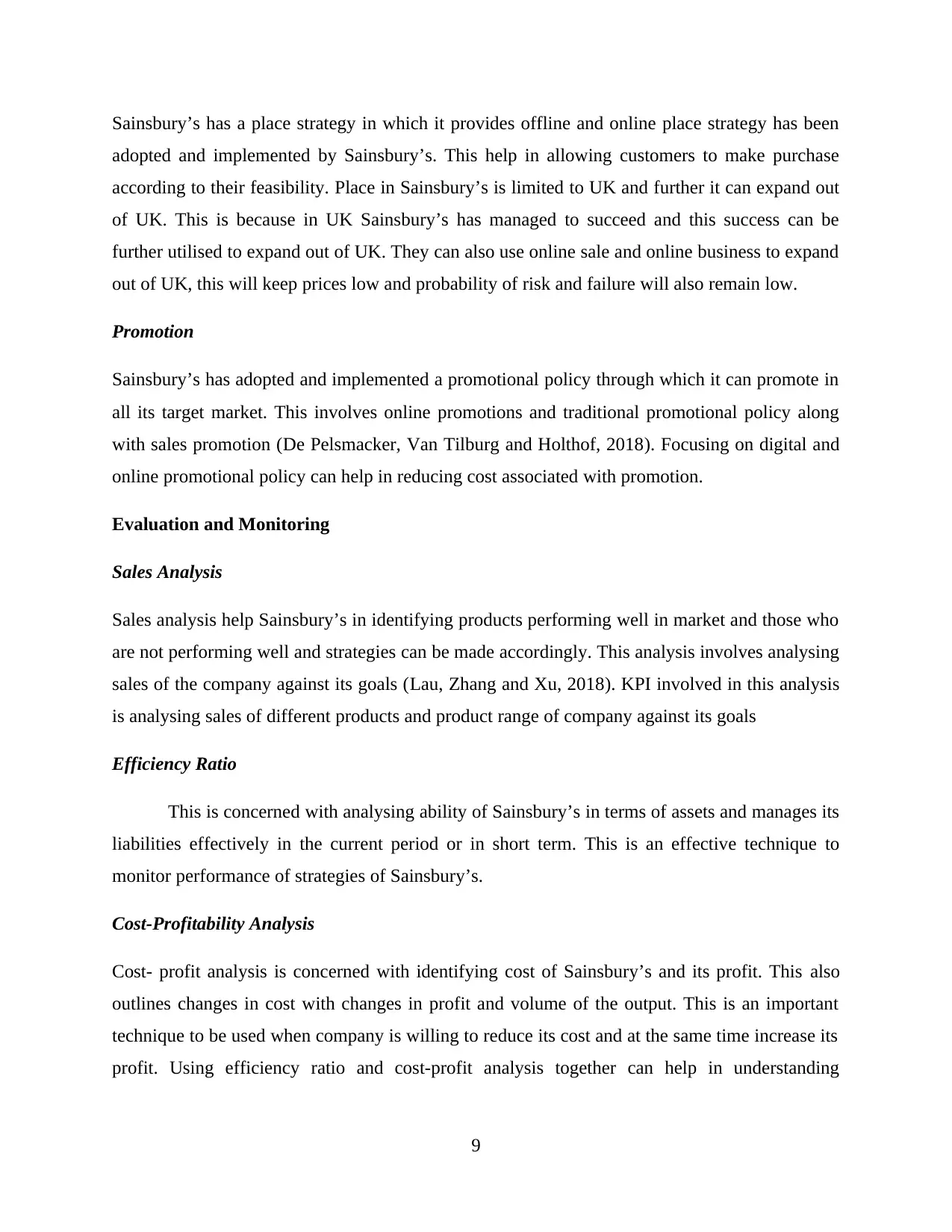
Sainsbury’s has a place strategy in which it provides offline and online place strategy has been
adopted and implemented by Sainsbury’s. This help in allowing customers to make purchase
according to their feasibility. Place in Sainsbury’s is limited to UK and further it can expand out
of UK. This is because in UK Sainsbury’s has managed to succeed and this success can be
further utilised to expand out of UK. They can also use online sale and online business to expand
out of UK, this will keep prices low and probability of risk and failure will also remain low.
Promotion
Sainsbury’s has adopted and implemented a promotional policy through which it can promote in
all its target market. This involves online promotions and traditional promotional policy along
with sales promotion (De Pelsmacker, Van Tilburg and Holthof, 2018). Focusing on digital and
online promotional policy can help in reducing cost associated with promotion.
Evaluation and Monitoring
Sales Analysis
Sales analysis help Sainsbury’s in identifying products performing well in market and those who
are not performing well and strategies can be made accordingly. This analysis involves analysing
sales of the company against its goals (Lau, Zhang and Xu, 2018). KPI involved in this analysis
is analysing sales of different products and product range of company against its goals
Efficiency Ratio
This is concerned with analysing ability of Sainsbury’s in terms of assets and manages its
liabilities effectively in the current period or in short term. This is an effective technique to
monitor performance of strategies of Sainsbury’s.
Cost-Profitability Analysis
Cost- profit analysis is concerned with identifying cost of Sainsbury’s and its profit. This also
outlines changes in cost with changes in profit and volume of the output. This is an important
technique to be used when company is willing to reduce its cost and at the same time increase its
profit. Using efficiency ratio and cost-profit analysis together can help in understanding
9
adopted and implemented by Sainsbury’s. This help in allowing customers to make purchase
according to their feasibility. Place in Sainsbury’s is limited to UK and further it can expand out
of UK. This is because in UK Sainsbury’s has managed to succeed and this success can be
further utilised to expand out of UK. They can also use online sale and online business to expand
out of UK, this will keep prices low and probability of risk and failure will also remain low.
Promotion
Sainsbury’s has adopted and implemented a promotional policy through which it can promote in
all its target market. This involves online promotions and traditional promotional policy along
with sales promotion (De Pelsmacker, Van Tilburg and Holthof, 2018). Focusing on digital and
online promotional policy can help in reducing cost associated with promotion.
Evaluation and Monitoring
Sales Analysis
Sales analysis help Sainsbury’s in identifying products performing well in market and those who
are not performing well and strategies can be made accordingly. This analysis involves analysing
sales of the company against its goals (Lau, Zhang and Xu, 2018). KPI involved in this analysis
is analysing sales of different products and product range of company against its goals
Efficiency Ratio
This is concerned with analysing ability of Sainsbury’s in terms of assets and manages its
liabilities effectively in the current period or in short term. This is an effective technique to
monitor performance of strategies of Sainsbury’s.
Cost-Profitability Analysis
Cost- profit analysis is concerned with identifying cost of Sainsbury’s and its profit. This also
outlines changes in cost with changes in profit and volume of the output. This is an important
technique to be used when company is willing to reduce its cost and at the same time increase its
profit. Using efficiency ratio and cost-profit analysis together can help in understanding
9
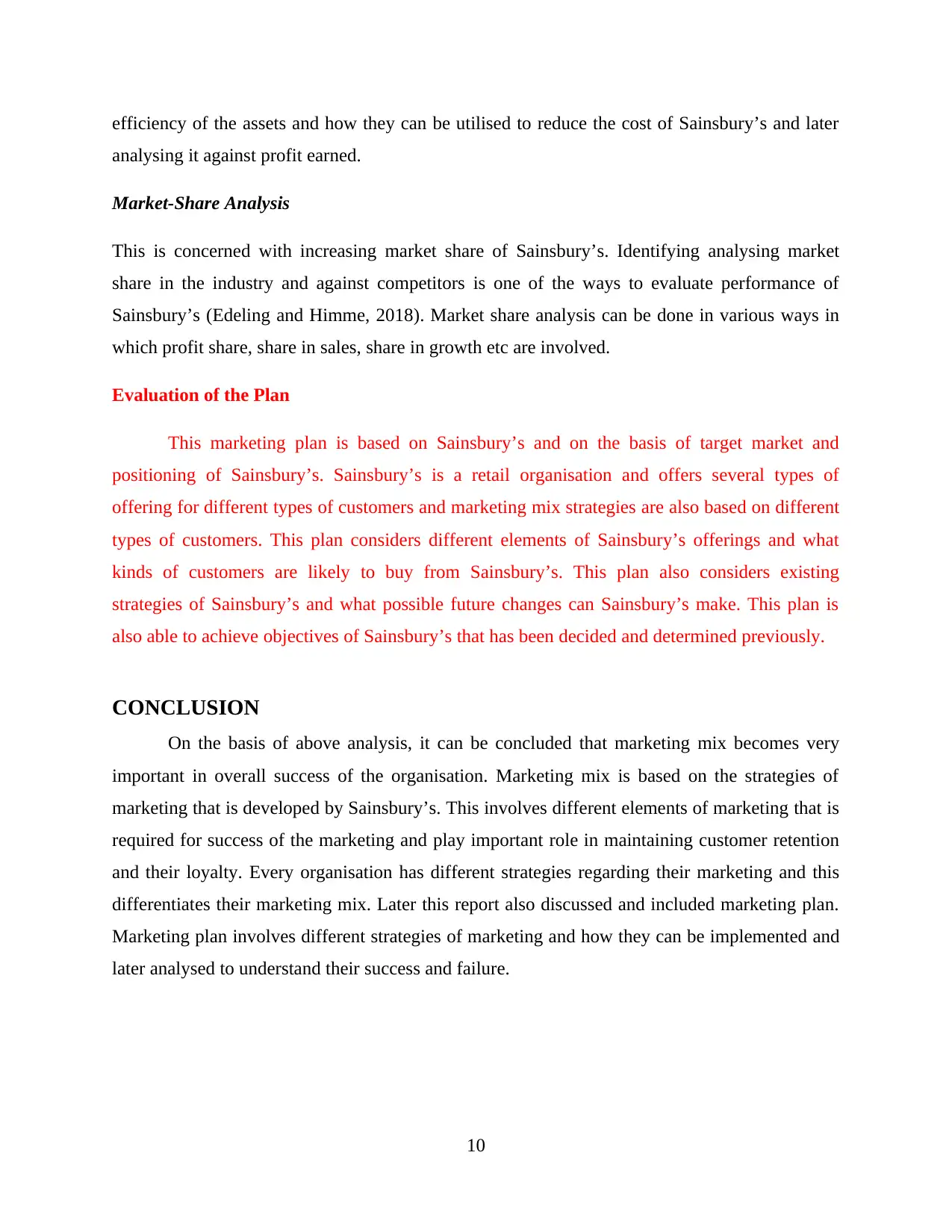
efficiency of the assets and how they can be utilised to reduce the cost of Sainsbury’s and later
analysing it against profit earned.
Market-Share Analysis
This is concerned with increasing market share of Sainsbury’s. Identifying analysing market
share in the industry and against competitors is one of the ways to evaluate performance of
Sainsbury’s (Edeling and Himme, 2018). Market share analysis can be done in various ways in
which profit share, share in sales, share in growth etc are involved.
Evaluation of the Plan
This marketing plan is based on Sainsbury’s and on the basis of target market and
positioning of Sainsbury’s. Sainsbury’s is a retail organisation and offers several types of
offering for different types of customers and marketing mix strategies are also based on different
types of customers. This plan considers different elements of Sainsbury’s offerings and what
kinds of customers are likely to buy from Sainsbury’s. This plan also considers existing
strategies of Sainsbury’s and what possible future changes can Sainsbury’s make. This plan is
also able to achieve objectives of Sainsbury’s that has been decided and determined previously.
CONCLUSION
On the basis of above analysis, it can be concluded that marketing mix becomes very
important in overall success of the organisation. Marketing mix is based on the strategies of
marketing that is developed by Sainsbury’s. This involves different elements of marketing that is
required for success of the marketing and play important role in maintaining customer retention
and their loyalty. Every organisation has different strategies regarding their marketing and this
differentiates their marketing mix. Later this report also discussed and included marketing plan.
Marketing plan involves different strategies of marketing and how they can be implemented and
later analysed to understand their success and failure.
10
analysing it against profit earned.
Market-Share Analysis
This is concerned with increasing market share of Sainsbury’s. Identifying analysing market
share in the industry and against competitors is one of the ways to evaluate performance of
Sainsbury’s (Edeling and Himme, 2018). Market share analysis can be done in various ways in
which profit share, share in sales, share in growth etc are involved.
Evaluation of the Plan
This marketing plan is based on Sainsbury’s and on the basis of target market and
positioning of Sainsbury’s. Sainsbury’s is a retail organisation and offers several types of
offering for different types of customers and marketing mix strategies are also based on different
types of customers. This plan considers different elements of Sainsbury’s offerings and what
kinds of customers are likely to buy from Sainsbury’s. This plan also considers existing
strategies of Sainsbury’s and what possible future changes can Sainsbury’s make. This plan is
also able to achieve objectives of Sainsbury’s that has been decided and determined previously.
CONCLUSION
On the basis of above analysis, it can be concluded that marketing mix becomes very
important in overall success of the organisation. Marketing mix is based on the strategies of
marketing that is developed by Sainsbury’s. This involves different elements of marketing that is
required for success of the marketing and play important role in maintaining customer retention
and their loyalty. Every organisation has different strategies regarding their marketing and this
differentiates their marketing mix. Later this report also discussed and included marketing plan.
Marketing plan involves different strategies of marketing and how they can be implemented and
later analysed to understand their success and failure.
10
Secure Best Marks with AI Grader
Need help grading? Try our AI Grader for instant feedback on your assignments.
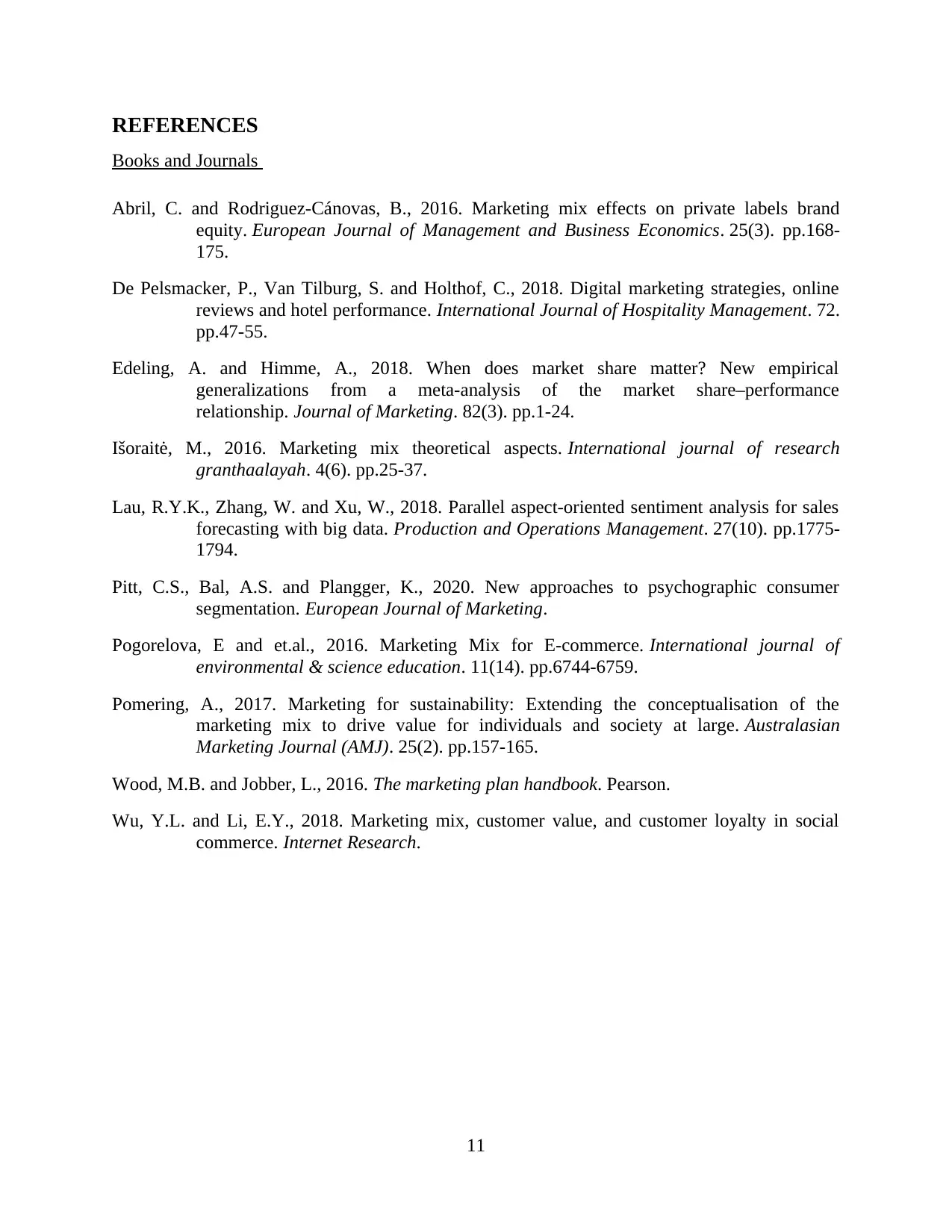
REFERENCES
Books and Journals
Abril, C. and Rodriguez-Cánovas, B., 2016. Marketing mix effects on private labels brand
equity. European Journal of Management and Business Economics. 25(3). pp.168-
175.
De Pelsmacker, P., Van Tilburg, S. and Holthof, C., 2018. Digital marketing strategies, online
reviews and hotel performance. International Journal of Hospitality Management. 72.
pp.47-55.
Edeling, A. and Himme, A., 2018. When does market share matter? New empirical
generalizations from a meta-analysis of the market share–performance
relationship. Journal of Marketing. 82(3). pp.1-24.
Išoraitė, M., 2016. Marketing mix theoretical aspects. International journal of research
granthaalayah. 4(6). pp.25-37.
Lau, R.Y.K., Zhang, W. and Xu, W., 2018. Parallel aspect‐oriented sentiment analysis for sales
forecasting with big data. Production and Operations Management. 27(10). pp.1775-
1794.
Pitt, C.S., Bal, A.S. and Plangger, K., 2020. New approaches to psychographic consumer
segmentation. European Journal of Marketing.
Pogorelova, E and et.al., 2016. Marketing Mix for E-commerce. International journal of
environmental & science education. 11(14). pp.6744-6759.
Pomering, A., 2017. Marketing for sustainability: Extending the conceptualisation of the
marketing mix to drive value for individuals and society at large. Australasian
Marketing Journal (AMJ). 25(2). pp.157-165.
Wood, M.B. and Jobber, L., 2016. The marketing plan handbook. Pearson.
Wu, Y.L. and Li, E.Y., 2018. Marketing mix, customer value, and customer loyalty in social
commerce. Internet Research.
11
Books and Journals
Abril, C. and Rodriguez-Cánovas, B., 2016. Marketing mix effects on private labels brand
equity. European Journal of Management and Business Economics. 25(3). pp.168-
175.
De Pelsmacker, P., Van Tilburg, S. and Holthof, C., 2018. Digital marketing strategies, online
reviews and hotel performance. International Journal of Hospitality Management. 72.
pp.47-55.
Edeling, A. and Himme, A., 2018. When does market share matter? New empirical
generalizations from a meta-analysis of the market share–performance
relationship. Journal of Marketing. 82(3). pp.1-24.
Išoraitė, M., 2016. Marketing mix theoretical aspects. International journal of research
granthaalayah. 4(6). pp.25-37.
Lau, R.Y.K., Zhang, W. and Xu, W., 2018. Parallel aspect‐oriented sentiment analysis for sales
forecasting with big data. Production and Operations Management. 27(10). pp.1775-
1794.
Pitt, C.S., Bal, A.S. and Plangger, K., 2020. New approaches to psychographic consumer
segmentation. European Journal of Marketing.
Pogorelova, E and et.al., 2016. Marketing Mix for E-commerce. International journal of
environmental & science education. 11(14). pp.6744-6759.
Pomering, A., 2017. Marketing for sustainability: Extending the conceptualisation of the
marketing mix to drive value for individuals and society at large. Australasian
Marketing Journal (AMJ). 25(2). pp.157-165.
Wood, M.B. and Jobber, L., 2016. The marketing plan handbook. Pearson.
Wu, Y.L. and Li, E.Y., 2018. Marketing mix, customer value, and customer loyalty in social
commerce. Internet Research.
11
1 out of 11
Related Documents
Your All-in-One AI-Powered Toolkit for Academic Success.
+13062052269
info@desklib.com
Available 24*7 on WhatsApp / Email
![[object Object]](/_next/static/media/star-bottom.7253800d.svg)
Unlock your academic potential
© 2024 | Zucol Services PVT LTD | All rights reserved.





